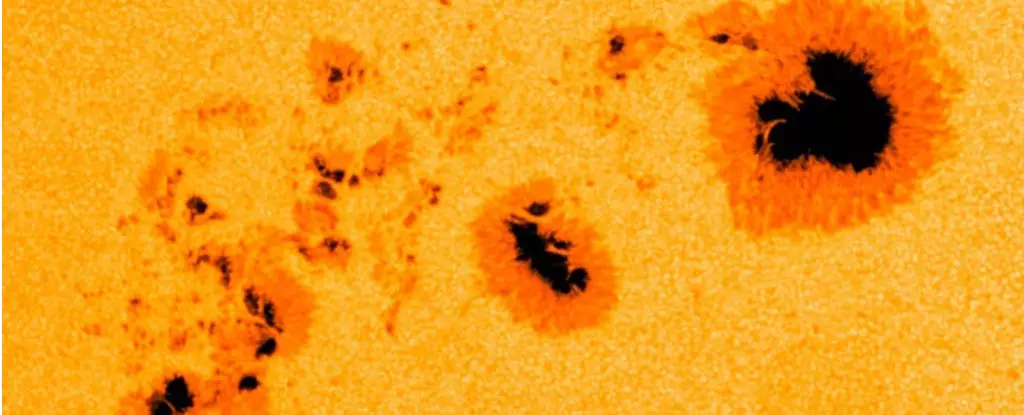The Sun is often celebrated as the luminary that sustains life; its rhythms dictate seasons, nurture vegetation, and regulate the delicate balance of our planet’s ecosystems. Historically, cultures around the world have looked to this celestial body, attributing to it almost mystical powers and vital significance. The understanding of the Sun has evolved over centuries, propelled by scientific inquiry and technological advancement. This article delves into the relationship between the Sun and Earth, particularly focusing on the fascinating phenomenon of sunspots, their cycles, and the magnetic activities they generate.
From ancient civilizations to modern societies, the Sun has commanded reverence and fascination. Cultures have long acknowledged its role as a source of warmth and illumination. It has been the subject of mythology and spiritual beliefs, often personified in rituals that honored the renewal of life brought forth by its light. This ancient connection emphasizes the significance of astronomy’s impact on early human civilizations, where the movements of celestial bodies directly influenced agricultural practices and social structures.
The application of the compass, stemming from ancient Chinese traditions, marked an important step in humanity’s relationship with the Earth and the cosmos. This tool enabled explorers and navigators to traverse vast distances with greater confidence, bridging the gap between terrestrial navigation and celestial understanding.
The path of scientific exploration regarding the Sun reached critical milestones with influential figures such as Galileo Galilei. In the 17th century, Galileo harnessed the power of the telescope to scrutinize the Sun closely, revealing dark spots marring its luminous face. These spots—a phenomenon now known as sunspots—initiated a long-standing intrigue within the astronomical community. They are not mere blemishes; they are indicators of solar magnetic activity linked to processes occurring deep within the Sun’s atmosphere.
Fast forward to the 20th century, George Ellery Hale’s monumental achievements brought the Sun under a new light. His innovations in telescopic design allowed for unprecedented insights into solar phenomena, showcasing areas where magnetic forces were particularly intense, thousands of times stronger than Earth’s own magnetic field. Hale’s contributions helped lay the groundwork for modern solar physics, particularly in recognizing the importance of magnetism in the behavior of sunspots.
A significant chapter in sunspot history is the Maunder Minimum, a puzzling 70-year period during the 17th century when sunspots were conspicuously absent. This interval, characterized by a stark reduction in sunspot activity, has intrigued scientists for centuries. Was it a natural fluctuation, or did external factors contribute to this cosmic dormancy? The reappearance of sunspots in 1715 restored balance to our understanding of solar cycles, highlighting the Sun’s ability to exhibit prolific activity followed by prolonged periods of calm.
The cyclical nature of sunspots—averaging an 11-year solar cycle—has emerged as a significant aspect of solar study. The ability to predict these cycles has implications not only for understanding solar activity but also for anticipating potential impacts on Earth’s technological systems.
The historical significance of solar events came to a head during the Carrington Event of 1859. As Richard Carrington sketched sunspots, he witnessed a dramatic transformation—an explosive solar flare that illuminated the sky. This event produced widespread auroras and triggered tumultuous magnetic storms that disrupted telegraph systems around the world.
The impact of such solar events is not merely historical; they underscore a critical vulnerability inherent in our technological society. As modern society increasingly relies on satellites and electrical infrastructure, understanding solar activity has become paramount. A similar event today could wreak havoc on our interconnected systems, demonstrating that while the Sun is synonymous with life, its wrath is not to be taken lightly.
Today, further progress in solar research deepens our understanding of magnetism and its implications. The magnetic energy concentrated in sunspots creates variations in temperature, allowing these areas to appear darker than their surroundings. Often, this energy is expelled in the form of coronal mass ejections (CMEs)—vast clouds of plasma and radiation that can pose risks when directly aimed at Earth.
The relationship between sunspots and auroras exemplifies the dynamic interplay between solar activity and terrestrial phenomena. When magnetic fields align favorably, the energies released can create stunning auroras. Conversely, misalignments and disruptions might merely result in localized disturbances, underlining the complexity inherent in solar-terrestrial interactions.
As we navigate through the current solar cycle, marked by an unexpected peak in sunspot activity, the dual capacity of the Sun to nurture and destroy continues to mesmerize scientists and laypeople alike. Understanding the Sun’s behavior is crucial for predicting its future impact on our world. With each advancement, we strengthen the bridge between ancient reverence and modern science, further unraveling the mysteries of this eternal beacon in our sky. The Sun remains an ever-evolving focus of human inquiry, alluringly blending beauty and peril in its cosmic dance.


Leave a Reply